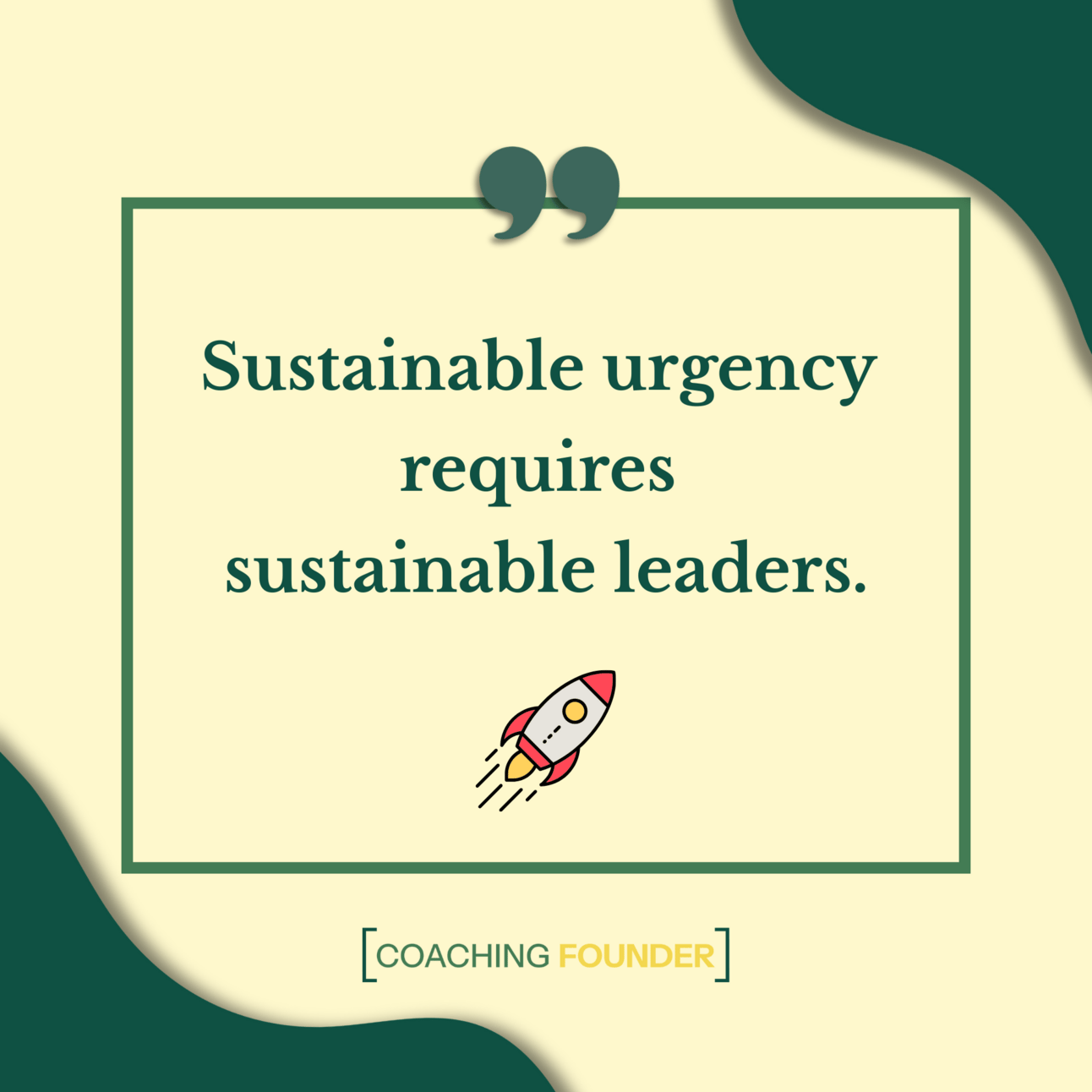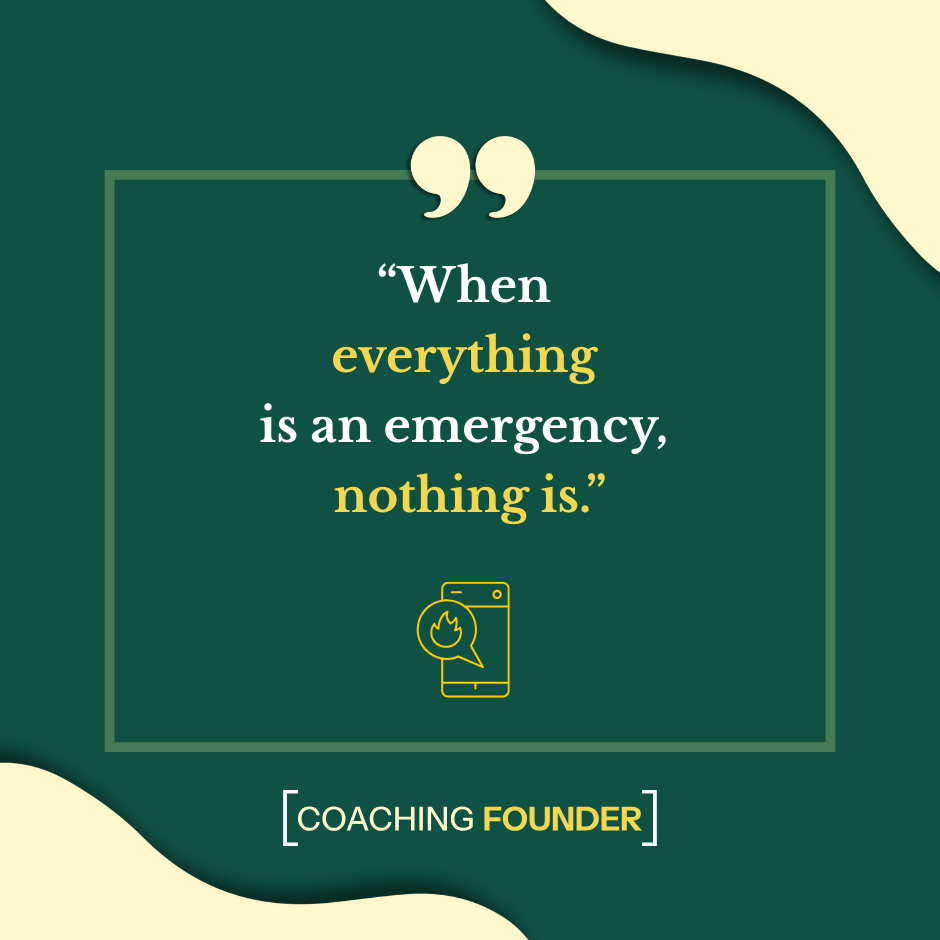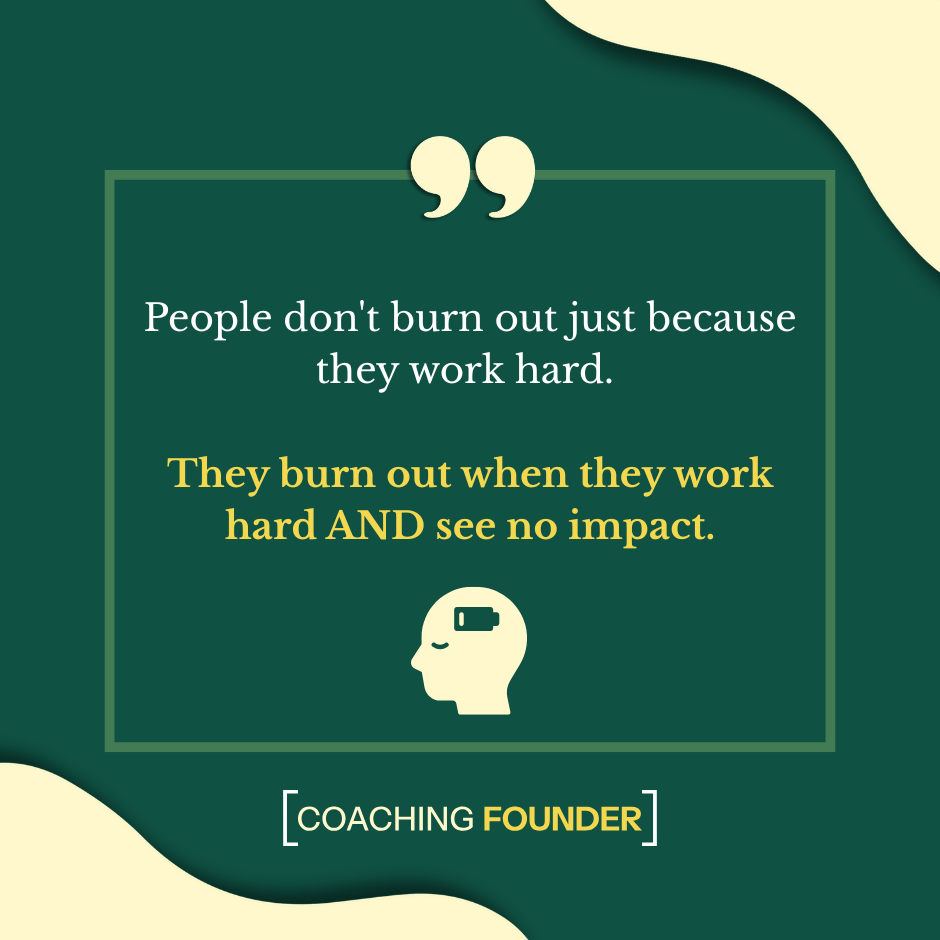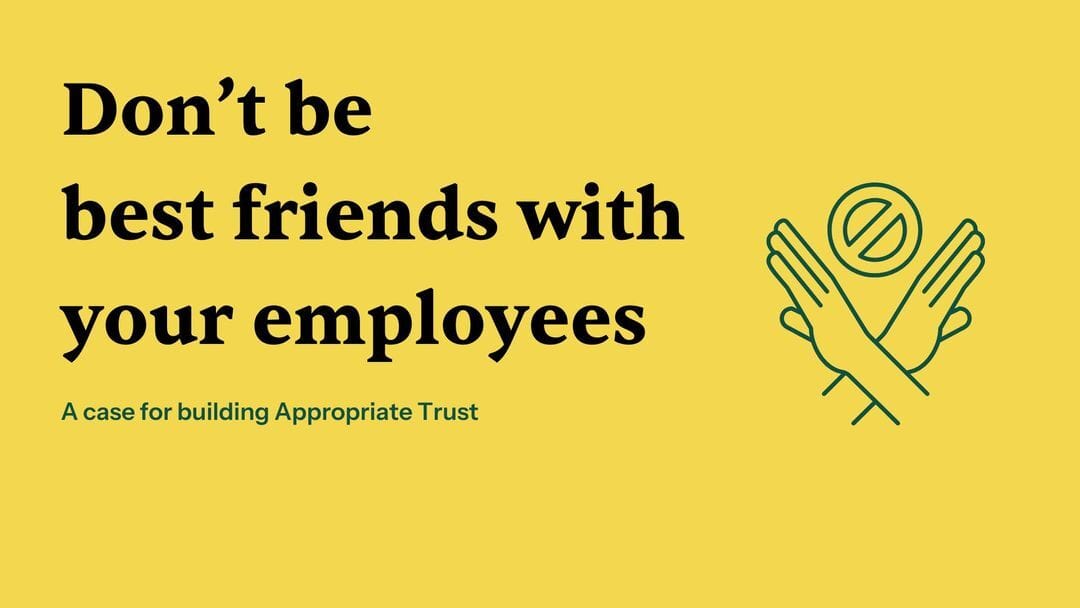- Force Multipliers
- Posts
- How to Create a ‘Culture of Urgency’ Without Inducing Panic
How to Create a ‘Culture of Urgency’ Without Inducing Panic
How to balance speed with sanity. (No one wins in fire-drill culture).
Hi! Welcome to another issue of Force Multipliers, your weekly briefing from Regina Gerbeaux, where Silicon Valley's behind-the-scenes operators get battle-tested frameworks for their toughest challenges, from putting out chaotic fires to managing strong personalities.
The fallacy of work-life balance
I remember once coaching a CEO of a very successful company. The CEO, Ricky, was like the energizer bunny: boundless amounts of stamina, constantly on, and a workaholic (he was proud of it, too.)
In a session, he told me:
“I don’t believe in work-life balance. My wife even pointed it out to me: she told me I’m happiest when I’m working, so why wouldn’t she want me to be at my happiest? We make it work between what I love to do and what she loves to do.”
On the internet, if Ricky ever posted anything like this, he would either be showered with praise for being a go-getter, or lambasted as a hustle porn addict.
…but what if he’s right? Is it such a bad thing to want to be at your happiest?
Our session got me thinking: his version of “work-life balance” was less about balance, which implies 50/50 time spent on each, and more about work-life harmony.
To me, one of the most annoying debates is whether work-life balance is a necessity, or a plague against productivity.
The reality is that it depends on the person! But every person has a different threshold for what “balance” looks like. Harmony feels more accurate.
Dear Regina,
I recently stepped into a COO role at a Series B company that's struggling to move quickly. Our CEO is constantly frustrated by our "lack of urgency" and keeps comparing us to competitors who seem to ship features twice as fast. The problem is, when I've tried to light fires under people, they either burn out or get defensive. I've already lost two senior engineers in the last quarter, and our Head of Product looks like she's about to break.
How do I create genuine urgency without destroying my team? I want us to move faster, but not at the cost of people's wellbeing or long-term retention.
(COO, Series B company, ~60 people, ~$45M raised)
Dear Operator,
The one thing every successful company has in common is a sense of deep urgency.
There’s no way around it - you can’t 10x a company, launch a product, or scale a team without moving fast.
But does that mean you have to burn out your team? Is that cost worth it?
Think of it like this: cortisol is the hormone your body releases in response to stress. In short bursts, cortisol is beneficial. It helps you sprint, focus, and respond to immediate challenges.
However, when cortisol levels remain elevated over prolonged periods, it becomes detrimental. Chronic high cortisol can lead to health issues such as insomnia, weakened immunity, and even chronic illnesses. Studies have shown that our modern lifestyles contribute to consistently higher baseline cortisol levels compared to previous generations, increasing the risk of long-term health problems.
For example, a Penn State study compared daily stress in the 1990s vs the 2010s and found a clear increase in stress exposure. On average, people in the 2010s reported more daily stressors than those in the ’90s. The effect was especially pronounced in mid-life adults: those aged 45–64 had 19% more daily stress in 2010 than their counterparts did in 1990, translating to 64 additional days of stress per year.
Similarly, The Study on Chronic Stress and Neurodegenerative Diseases highlighted how chronic stress leads to excessive cortisol production, contributing to neuro-degenerative diseases like Alzheimer's and Parkinson's. And a meta-analysis of 48 studies found that older adults exhibit increased cortisol secretion or reduced cortisol inhibition in response to stress, indicating a trend of elevated cortisol levels with age.
So, while urgency is essential for progress, unchecked and constant pressure can deplete your team's energy and well-being.
👉 I think you can have your cake and eat it too: creating a sense of urgency that isn’t powered by fear or resulting in burnout. 🍰
Today, I want to talk about how to create urgency without spiraling into burnout. It’s a lesson I feel strongly about, not only because it happens so often in Silicon Valley, but because of my personal experience from when I spent a decade as a teacher - one of the highest-burnout professions in the world.
The Playbook on Building Urgency
Without Burnout
Step 1: Start with yourself - your team is watching.
The fastest way to burn out your team is to burn yourself out first.
A while ago, I coached a COO at a fintech company who bragged about getting four hours of sleep, skipping meals, and responding to teammates on Slack and iMessage at 2am. Meanwhile, his team was falling apart. When we dug into why, I discovered something he couldn't see: his behavior was creating implicit expectations that destroyed his team's boundaries.
What you model gets mirrored. If you're constantly online, sending late-night messages, skipping lunch, and sacrificing weekends you're normalizing self-harm masquerading as commitment. Your team pays more attention to what you do, than what you say.

This doesn't mean you can't work hard or put in occasional crunch periods! But sustainable urgency requires sustainable leaders.
If you struggle with turning the mirror back at yourself, you might need to hire a coach to help you find your blind spots. But here are some telltale signs you’re not working sustainably:
You regularly use caffeine, alcohol, narcotics, or other substances to function day-to-day.
You get sick, deal with health issues, or deprioritize your physical health through lack of quality sleep or poor nutrition.
You lash out at others and easily lose your temper, or you’re easily irritable
You have little to no personal life, evidenced by canceling quality time with friends, your spouse, children, or outside community
You find it difficult to disconnect mentally, even when you’re physically away
If you answered yes to these, you've moved beyond healthy urgency into unhealthy sacrifice. And your team will follow.
💊 The Remedy: block actual recovery time in your calendar, and make sure your team sees you honoring it. When your team sees you protecting your health, they'll feel permission to protect theirs.
Step 2: Hire people who naturally run hot.
I remember talking with a founder who was constantly frustrated that his team didn't seem to care enough. We talked about the company’s Talent Density bar - that is, how many people on the team he would fight hard to keep if they were to leave the next day for another company. He admitted he would really only feel sad if 2 of his teammates left, because they were heavy hitters.
When evaluating the lower-performing, lower-output teammates, we discovered he was optimizing for credentialism over actual drive. Soon, he shifted away from credentials on where candidates worked or went to school, and searched for evidence that candidates completed self-motivated projects, contributed to their teams in meaningful (but not prescriptive) ways, and otherwise pursued personal goals without external pressures.
In other words, we sourced for self-driven people.
Within six months of adjusting his hiring criteria, his complaints about urgency had almost disappeared.
Some people have an intrinsic drive that makes external motivation unnecessary. They're naturally curious, competitive with themselves, and get genuine satisfaction from shipping great work quickly.
These people are unicorns. Hire yourself a team of unicorns, whenever possible.
Unicorns are expensive. Pay them accordingly - top of market, or above market. One of them will outwork three regular horses, so you still win in the end. 🦄 > 🐴 🐴 🐴
💡 Implement: Search for people who have evidence of self-drive.
Telltale signs include someone who learns things for fun, reads on their own, is naturally curious, and works on projects obsessively.
⛔ Beware: Measuring for vanity metrics.
Too many CEOs value “first in, last out” over quality work. Often, CEOs forget to ask themselves if those employees are actually good, or if they’re just playing the optics game (or really inefficient.) Focus on output, not hours.
Step 3: Focus urgency where it matters, not everywhere.
I remember talking to a CEO who couldn't understand why her urgent requests weren't getting traction anymore. "I keep telling them this is critical, but nobody moves faster," she told me.
We tracked her Slack messages for two weeks and found she'd used the words "urgent," "critical," or "ASAP" an ungodly number of times. She surprised herself at how urgently she treated everything, but got a bit defensive when I pointed this out: “What if everything is urgent?”
I told her: When everything's an emergency, nothing is.

Think of your team's energy like a fire department. 🚒
Not every alarm requires the entire squad and all the trucks. Some incidents need a full emergency response (real fires!), while others are just fire drills (remember those from grade school?)
One of the most common mistakes is treating everything as a five-alarm fire. This is the fastest path to creating a numb, disengaged team.
Sustainable urgency requires meaningful prioritization. Choose your battles carefully.
❓ Here are three questions you can ask yourself to focus urgency where it matters:
👉️ Which initiatives truly move the company-critical metrics?
👉️ Where will focused effort create exponential rather than incremental gains?
👉️ What work, if accelerated, unlocks multiple downstream benefits?
Be ruthlessly honest about what needs speed and what doesn't. Then, when you do call for urgency, it will actually mean something.
Step 4: Create visible wins and celebrate them properly.
When I coach startups, one thing leaders frequently miss is connecting daily tasks to direct customer impact.
Don’t make this mistake! Nothing kills motivation faster. Your team starts wondering, "Why am I even doing this?" Soon, urgency disappears, burnout creeps in, and people stop caring about deadlines.
The work feels pointless because no one sees how it actually helps the people you're building for.
People don't burn out just because they work hard. They burn out when they work hard and see no impact.

The inverse is true, too! The most motivated teams that move at high velocity are intimately acquainted with the customer’s problems. They understand why their customer’s life sucks, and see the direct impact their work has on the customer’s life.
I’ve seen this work for…
Engineering teams that weren’t shipping quickly enough or honoring ticket/product deadlines
Customer success teams that had churn rates that were too high due to lack of urgency
Sales teams that had difficulty selling because of lack of follow through
💡 Implement: If I’ve convinced you that direct customer impact visibility is important, here are some things you can do to bolster this at your company:
🟢 Create a #customer-wins channel and post screenshots any time testimonials come through.
🟢 End all All Hands Meetings with a Wall of Love graphic where you showcase customers that love your product.
🟢 Tie back demos engineers create to “OMG” moments your team experiences.
🟢 Celebrate not only big launches, but meaningful progress as well.
Make it impossible for your team to forget why urgency matters.
Step 5: Care about the whole human, not just the worker.
Long before I became a coach, I once spoke with a Chief of Staff who said something very concerning to me.
He was gleefully bragging about how no one at his company used their health and wellness stipend.
In his words:
“I love that we offer the stipend as a, ‘Use it if you want’ perk, because the best thing for the company is if no one uses it. That way, we save money, and still get to say we offer it. Isn’t that great? We offer something, but also have cost savings. We just don’t remind anyone to use it. It’s sort of like PTO. If you don’t remind people to use it, then they won’t!”
Though I’m not violence-prone, I would be lying if I said I didn’t want to punch him in the face right then and there. 😡
The craziest part was, this company was flush with cash! They had raised a very successful round, had customers that were eager to spend their money, and plenty of runway.
What they didn’t have were happy, healthy employees. The Chief of Staff (and therefore, also the CEO) had no idea that 80% of the team was burned out and mentally checked out.
The company crumbled about a year later.
Sustainable urgency requires reserve capacity. Think of it like the reserve gallon in your gasoline tank. Your range might say zero, but you don’t want it to be truly at zero, lest you need a (very expensive) tow truck.
If your team is constantly maxed out, they'll have nothing extra to give when true urgency hits.
How do you encourage the reserve capacity, then? Simple: understand what matters to each person, beyond money and the immediate work they do for your company.
This doesn’t mean you have to be best friends with your employees - in fact, I write about this here:
…but “Appropriate Trust” - trust with clear boundaries in place - is enough for you to care about the whole human, without crossing any blurry, HR-concerning lines.
Counterintuitively, caring about people's lives outside work makes them more invested in work itself. It creates the psychological safety needed for sustainable urgency rather than fear-based sprinting.
👉 Every manager should set up regular time to understand:
🟠 What personal goals team members are pursuing, to the extent the employee feels comfortable sharing.
🟠 What circumstances might be affecting their capacity.
🟠 What support would help them thrive both at work and outside it.
Conclusion
In summary, here are the five things you can do to create urgency without burning your team out:
Audit your own behaviors.
See how you’re creating burnout in your team by burning yourself out.Hire hot ones already:
optimize for the unicorns that have intrinsic motivation and drive.Decide how urgent something TRULY is.
Audit how often you sound the fire alarm.Tie the work back to the customer’s happiness level
and make it stupidly visible and obvious to your team.Understand the whole person
not just the work person.
Ultimately, sustainable urgency comes from alignment between what matters to the company and what matters to the people within it. When these align, people naturally move quickly toward goals that matter, without you having to crack the whip.
Until next time,

Resources linked:
You don’t have to be best friends with your team | Coaching Founder
Was this newsletter forwarded to you? Are you here for the first time? If so, remember to subscribe below…
 | Want to know the fastest way to kill urgency? Micromanaging every single thing. When you're drowning in the weeds, you can't see the forest. You become the bottleneck instead of the accelerator. |
That's exactly why having a world-class EA isn't a nice-to-have. It's mission-critical for any operator who wants to move fast without losing their mind.
I've been working with Atlas Assistants for two years now, and honestly? It changed everything. After cycling through multiple EA agencies that promised the world and delivered mediocrity, Atlas was different. They don't just throw warm bodies at you - they pair you with EAs trained in their Executive Management System, the same framework 7 and 8-figure founders use to reclaim their time and focus.
You get a proactive operator, not someone waiting for your next task. They anticipate what you need before you even know you need it. That's how you maintain urgency without the chaos.
Want more operational content?
Check out Coaching Founder for over a dozen free, downloadable Notion templates to use at your company, and tons of write-ups on how to level up your execs, your teams, and yourself.
About Regina Gerbeaux
 | Regina Gerbeaux was the first Chief of Staff to an executive coach who worked with Silicon Valley’s most successful entrepreneurs, including Brian Armstrong (Coinbase), Naval Ravikant (AngelList), Sam Altman (OpenAI / Y Combinator), and Alexandr Wang (Scale). |
Shortly after her role as Chief of Staff, then COO, she opened her own coaching practice, Coaching Founder, and has worked with outrageously talented operators on teams like Delphi AI, dYdX, Astronomer, Fanatics Live, and many more companies backed by funds like Sequoia and Andreessen Horowitz.
Her open-sourced write-ups on Operational Excellence and how to run a scaling company can be found here and her templates can be found here.
She lives in the Pacific Northwest with her partner Lucas and dog Leia, and can be found frequenting 6:00AM Orangetheory classes or hiking trails nearby.



Reply